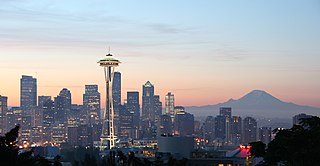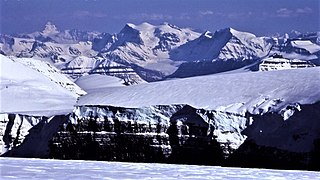
British Columbia (BC) is the westernmost province of Canada, situated between the Pacific Ocean and the Rocky Mountains. In the 2016 Census, the province's recorded population was 4,648,055, making it Canada's third-most populous province. The capital of British Columbia is Victoria, the fifteenth-largest metropolitan region in Canada, named for Queen Victoria, who ruled the British Empire during the creation of the original British colonies in Canada. The largest city is Vancouver, the third-largest metropolitan area in Canada, the largest in Western Canada, and the second-largest in the Pacific Northwest. In October 2013, Greater Vancouver had an estimated population of approximately 2.5 million. Since 2017, the province has been governed by the New Democratic Party, led by John Horgan, first with a minority government elected in 2017 and subsequently with a majority government elected in 2020.

The Rocky Mountains, also known as the Rockies, are a major mountain range in western North America. The Rocky Mountains stretch 3,000 mi (4,800 km) in straight-line distance from the northernmost part of British Columbia, in western Canada, to New Mexico in the Southwestern United States. The northern terminus is located in the Liard River area east of the Pacific Coast Ranges, while the southernmost point is near the Albuquerque area adjacent the Rio Grande Basin and north of the Sandia–Manzano Mountain Range. Located within the North American Cordillera, the Rockies are distinct from the Cascade Range and the Sierra Nevada, which all lie farther to the west.

The Scheldt is a 350-kilometre-long (220 mi) river that flows through in northern France, western Belgium, and the southwestern part of the Netherlands, with its mouth at the North Sea. Its name is derived from an adjective corresponding to Old English sceald ("shallow"), Modern English shoal, Low German schol, West Frisian skol, and Swedish (obsolete) skäll ("thin").

The Pacific Northwest (PNW), sometimes referred to as Cascadia, is a geographic region in western North America bounded by the Pacific Ocean to the west and, loosely, by the Rocky Mountains to the east. Though no official boundary exists, the most common conception includes the Canadian province of British Columbia (BC) and the U.S. states of Idaho, Oregon, and Washington. Broader conceptions reach north into Southeast Alaska and Yukon, south into northern California, and east to the Continental Divide to include Western Montana and parts of Wyoming. Narrower conceptions may be limited to the coastal areas west of the Cascade and Coast mountains. The variety of definitions can be attributed to partially overlapping commonalities of the region's history, culture, geography, society, and other factors.

In the nineteenth century, the Oregon Country was a disputed region of the Pacific Northwest of North America. The region was occupied by British and French Canadian fur traders from before 1810, and American settlers from the mid-1830s, with its coastal areas north from the Columbia River frequented by ships from all nations engaged in the maritime fur trade, most of these from the 1790s through 1810s being Boston-based. The Oregon Treaty of 1846 ended disputed joint occupancy pursuant to the Treaty of 1818 and established the British-American boundary at the 49th parallel.

The Canadian Rockies or Canadian Rocky Mountains comprise both the Alberta Rockies and the B.C. Rockies in the Canadian segment of the North American Rocky Mountains. They are the eastern part of the North American Cordillera, which is a system of multiple ranges of mountains which runs from the Prairies to the Pacific Coast. The Canadian Rockies mountain system comprises the central/eastern part of this system, lying between the Interior Plains of Alberta and northeastern British Columbia on the east to the Rocky Mountain Trench of BC on the west. The southern end of the Canadian Rockies borders Idaho and Montana of the United States. In geographic terms, the boundary is at the Canada–United States border, but in geological terms it might be considered to be at Marias Pass in northern Montana. The northern end is at the Liard River in northern British Columbia.

Crowsnest Pass is a low mountain pass across the Continental Divide of the Canadian Rockies on the Alberta–British Columbia border.

Valenciennes is a commune in the Nord department in northern France.

The Okanagan, also known as the Okanagan Valley and sometimes as the Okanagan Country, is a region in the Canadian province of British Columbia defined by the basin of Okanagan Lake and the Canadian portion of the Okanagan River. It is part of the Okanagan Country, extending into the United States as Okanogan County in north-central Washington. According to the 2016 Canadian census, the region's population is 362,258. The primary city is Kelowna.
Kootenay, Kootenai, and Kutenai may refer to:

Athabasca Pass is a high mountain pass in the Canadian Rockies on the border between Alberta and British Columbia. In fur trade days it connected Jasper House on the Athabasca River with Boat Encampment on the Columbia River.

Height of the Rockies Provincial Park is a provincial park in the Canadian Rockies of south eastern British Columbia, Canada. It is located west of the Continental Divide, adjacent to Elk Lakes Provincial Park.
The Bush River is a tributary of the Columbia River in the Columbia Country of southeastern British Columbia, Canada, entering that river via the Bush Arm of Kinbasket Lake. Named for the dense vegetation lining its banks, its headwaters are at 52°05′N117°30′W, in the Rocky Mountains. Its former confluence with the Columbia was at 51°44′30″N117°38′10″W, now beneath the waters of Bush Arm; a few miles above the river's new mouth is the confluence of the Valenciennes River. The Bush has also been designated the North Fork Bush River, while the Valenciennes was known as the South Fork Bush River ; — Bush Pass is at the head of the Valenciennes, rather than the Bush.
The Valenciennes River is a tributary of the Bush River, entering that river just above its mouth into Kinbasket Lake, the reservoir on the Columbia River created by the Mica Dam in southeastern British Columbia, Canada. The Valenciennes was originally known as the South Fork Bush River. Headwaters form on the south slope of Valenciennes Mountain.
Bush Pass is a mountain pass in the Canadian Rockies, on the border between the Canadian provinces of Alberta and British Columbia. it is located at the headwaters of the Valenciennes River, formerly known as the South Fork Bush River; the North Fork Bush River is now known as the Bush River.
Bonaparte is an Italian surname. It derives from Italian bona (buona) 'good' and parte 'solution' or 'match'.

Valenciennes Mountain is a 3,150-meter-elevation (10,330-foot) mountain summit located in the Canadian Rockies of British Columbia, Canada. Valenciennes Mountain is situated at head of Valenciennes River, one kilometer west of the British Columbia-Alberta border, and the same distance outside the Banff National Park boundary. Arras Mountain is 6 km (3.7 mi) to the west, and both are in the Kootenay Land District. The peak was named in 1920 for the French town of Valenciennes, which was captured by the Allies and entered by Canadian Expeditionary Force troops on 2 November 1918 following intense fighting in World War I. The name was officially adopted in 1930 when approved by the Geographical Names Board of Canada. Canadian soldier Hugh Cairns was awarded the prestigious Victoria Cross for conspicuous bravery during the battle. The first ascent of the mountain was made in 1934 by H. S. Kingman and J. Monroe Thorington, with guide Rudolph Aemmer.











